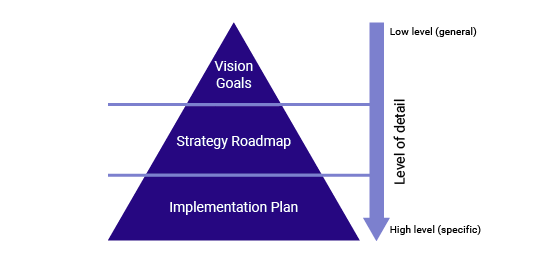
Introduction
Digital transformation has been a popular topic through the past decade, but many small and medium sized enterprises (SMEs) do not know what it really is and how it can benefit their businesses. Put it simply, digital transformation “is about using digital technologies to make the current logistical and administrative business processes that underpin day-to-day operations more efficient – thereby enabling the business to be more competitive”[1]. However, it is not an easy thing to do. Digital transformation “is an ongoing process that must ensure the business remains competitive into the future, constantly finding new efficiencies and reducing costs further” [1]. Therefore, this article will explain three main elements of digital transformation, including digital commercialisation, business optimisation, and digital strategy roadmap, in order to keep SMEs competitive in such a fast-paced market.
Digital Commercialisation

With more people searching and buying online than ever before, digital commercialisation has become vital. Essentially, “it allows SMEs to effectively put their brand in front of their target audience at the right time and in the right place, in a cost-effective and measurable way” [2].
Website/ Mobile App/ E-commerce
To broaden the sources of income, SMEs can attract customers through their websites, and mobile applications. It is essential to be found online because it is the nature of business in contemporary society. Consumers frequently search for a product or service online in order to find out more about the business. If a SME does not have a website or social media presence, it will be almost impossible and unbearable to compete.
Case Study: E-commerce website development and strategy for SearchingC.com
Case Study: Artificial Intelligence (AI) application in E-commerce
Customer Relationship Management (CRM) System
Another way to increase a company’s customer base, SMEs can utilize their CRM systems. A CRM system can improve customer satisfaction as “all dealing involving servicing, marketing, and selling your products and services to your customers can be conducted in an organized and systematic way” [3]. For example, when settling an issue for a customer, a staff member can access all information related to that customer, including past purchases, and preferences to resolve a problem quickly. When customers are satisfied, they are more likely to come back as well as to introduce the product or service to their family and friends. Therefore, SMEs should implement a good CRM system to retain and attract consumers.
Case Study: Customer loyalty program mobile application for a Macau shopping mall
Case Study: eDM (Electronic direct mail) development for global insurance company
Business Optimisation

Source: https://www.sarahmacklineditor.com/2018/09/14/business-optimisation-and-the-benefits/
Business optimisation is an important part in digital transformation because it helps to make a business as efficient as possible. This process aims to find the most appropriate alternative with the most economical or highest achievable performance, under the given limitations.
According to an Equisys article, there are several ways to benefit from business optimisation including:
- Better time management: sending invoices, statements and purchase orders digitally frees up staff members to be involved in more profitable tasks
- Reduced the amount of paper used: substitute paper with digital processing leads to “less storage and less risks of loss of physical documents” [1]
- Faster response time and better-quality customer service: documents that are filed electronically can be placed and accessed more quickly, so customer inquiries can be solved more quickly
- Enhancement of team morale: job satisfaction may increase because staffs can be arranged to do less repetitive and boring tasks
- Reduction in mistakes: digital processing of invoices and other documents is less liable to managing errors
Case Study: Data App for Global Elevator Provider
Case Study: MLM (Multi-level marketing) System development for a Hong Kong listed company
Digital Strategy Roadmap
Although the process of digital transformation may seem daunting at the beginning, the key to success is to establish a digital strategy that sets out a roadmap and targets for the future.
Perhaps you have an overall vision on what the company should look like in the future. Yet, before you plunge into planning and implementing a digital transformation process, you need to design a digital strategy roadmap that bridges the interval between vision and implementation planning.

A realistic digital strategy roadmap should at least outline why a company needs digital transformation, what does a company need to transform, what changes are compulsory in order to transform, and how does a company sequence the packages of change over a transformation time scope.
If a business does not have a credible plan “for where it wants to go with digital and actionable insight to refine direction on a continuous basis, it can end up making unfocused digital investments that fail to deliver a return on investment or have any measurable impact on the business goals” [4]. This highlights that an efficient roadmap offers a business with advice and direction that are essential to digital transformation.
Case Study: Car Parking System Data Warehouse Solutions
Case Study: Digital Consultancy Service for New Web Content Management System for West Kowloon Cultural District
Conclusion
Digital transformation is an important process for SMEs in order to stay competitive in the market. There are three main elements mentioned above, including digital commercialisation, business optimisation, and digital strategy roadmap. Every organization should design its own transformational process because each company has its own unique culture, desires, and objectives. The key to success is to transform step by step by implementing executable strategies. What are you waiting for? The time to start planning and embrace digital technology to improve your business is now!
References
[1] https://www.equisys.com/blog/what-does-digital-transformation-actually-mean-for-smes
[2] https://www.sqdigital.co.uk/the-benefits-of-digital-marketing-for-smes/
[3] https://blog.perfectmind.com/benefits-of-using-crm-for-your-business
[4] https://inviqa.com/blog/how-create-digital-roadmap-and-why-you-need-one


 Hide Menu
Hide Menu

